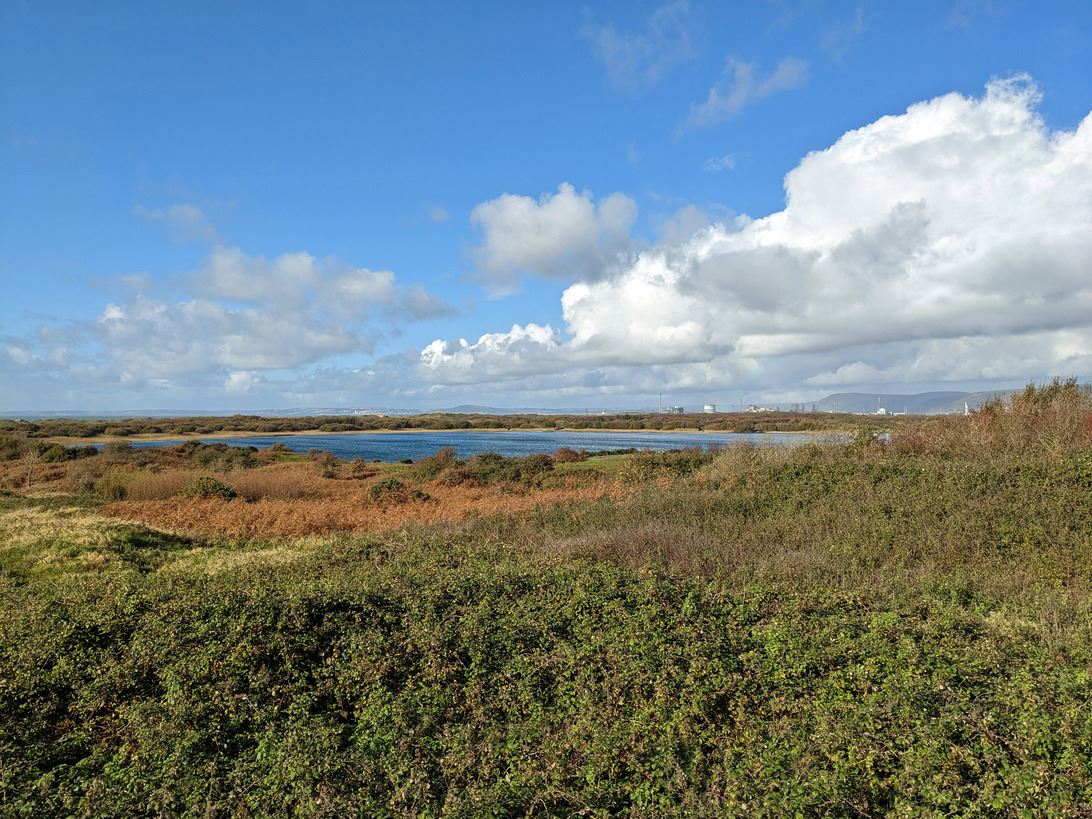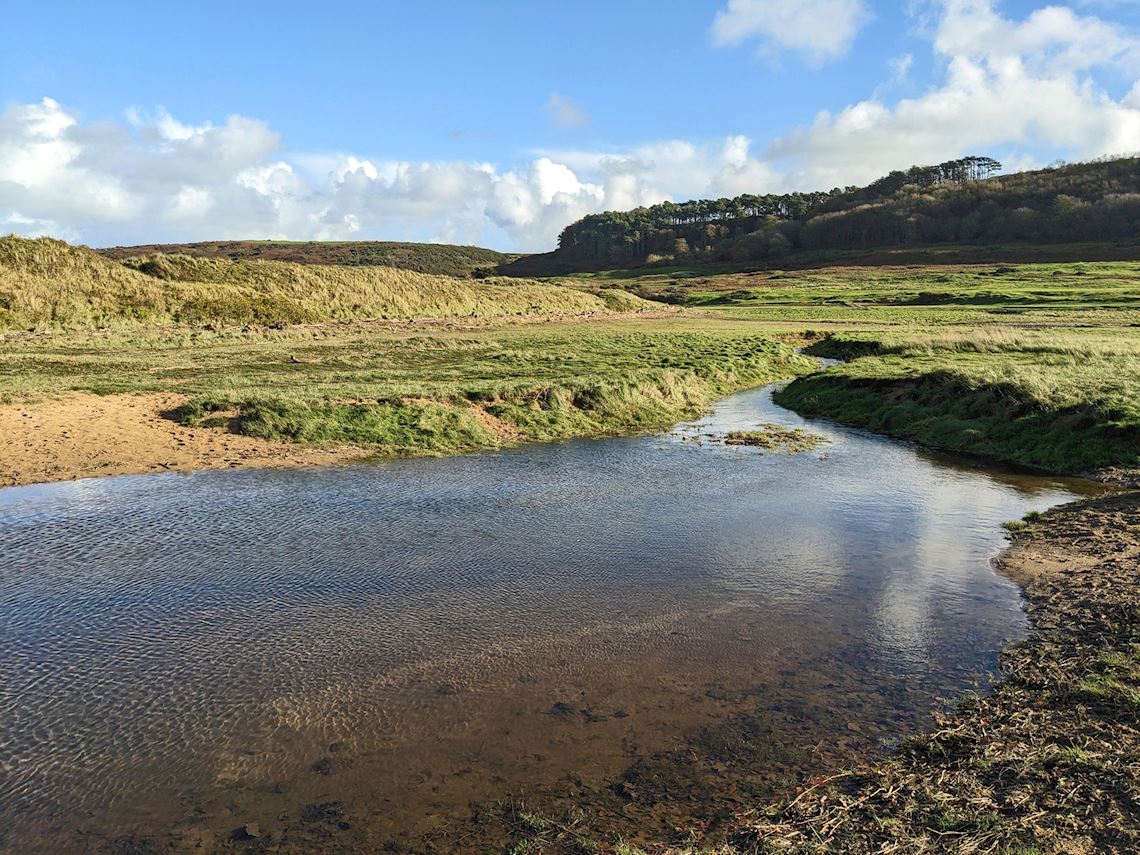Kenfig National Nature Reserve

Paddy Dillon
The Kenfig National Nature Reserve is centred on Kenfig Pool, which is popular with birdwatchers. The area includes extensive dunes featuring woodland, scrub, marshes and a hidden castle. A maze of paths are available and the ones described are mostly waymarked and obvious, linking with the Wales Coast Path.
Route detail
Distance: 5.9 miles or 3.7 kilmetres to 8.3 miles or 5.1 kilometres
Start location: Kenfig Visitor Centre
Start Grid Ref: SS 80142 81036
Start What 3 Words: beyond.masks.scored
Transport to the start
Parking
Parking at Kenfig Visitor Centre
Bus
None.
Train
None.
Map and GPX link
The circular route is marked in dark pink in the map image below. The purple flags show the start and finish point. Three GPX tracks are provided. ‘Kenfig Reserve 1’ is the shortest and omits the path to and from the castle. ‘Kenfig Reserve 2’ includes the path to and from the castle. ‘Kenfig Reserve 3’ includes the path to and from the castle and also takes a slightly longer route back to the starting point. All three routes are marked on the Ordnance Survey map.

Detailed Route Description
Note that a number of options are available around the Kenfig National Nature Reserve. The walk starts with a short exploration of Kenfig village, which was founded after drifting sand completely buried an earlier settlement. The walk to and from the ruins of Kenfig Castle are optional. If you omit this part then you save just over 1 mile. Towards the end, there are two options to finish, and these differ by only a few hundred yards.
1. Start at the car park at the Kenfig Reserve Centre, and be sure to go into the centre if it is open. In the winter, some of the paths on the reserve get waterlogged and the staff can offer advice. At all times of the year, birdwatchers can check at the centre to discover which species are currently living on the reserve. Bird hides are available beside Kenfig Pool, but are not visited on this walk.
2. Follow a tarmac path gently downhill from the car park, turning right at a path junction, then soon after that, turn left to pass a well. Kenfig villagers used to draw their water from here. Turn right along a grassy path flanked by bushes, bracken and brambles. This leads to a road in the village, so turn left to follow it and use the tarmac path alongside. There are a few old buildings worth noting, starting with Kenfig Farmhouse, followed by the thatched Pool Farm, then Kenfig Farm and the Prince of Wales pub. The village was founded as a result of an earlier settlement near Kenfig Castle becoming overwhelmed by drifting sand in the 15th century. The pub served as a town hall in the 17th century in the new settlement.
3. Pass a bus shelter (no bus service) where a public footpath signpost offers access to the nature reserve. However, walk a little further along the road and turn left along another path, passing a nature reserve noticeboard. Follow the path a short way through bracken and go through a gate in a fence. Continue gently downhill along the path and decide whether to continue in this direction, or turn right up a sandy path to visit the hidden ruins of Kenfig Castle, returning to this point later.
4. For Kenfig Castle, walk up the sandy path to a marker post, then go down between vegetated sand dunes, spotting more marker posts. A short duckboard crosses a wet patch in a wooded area. Go through a kissing gate, then the path becomes vague, so walk ahead a short way, turn left, then almost immediately turn right. The path passes between two small concrete blocks embedded in the ground, and this confirms the correct direction. Later, the path crosses several concrete blocks embedded in the ground. Reach a marker post that indicates a right turn, but also look ahead to spot a fragment of masonry rising above a tangle of thorn bushes. This is the only clue to the location of Kenfig Castle, and if a path through the bushes is found, it is surprising how much more of the castle can be seen. Retrace steps faithfully to continue.
5. Continue walking down the path, turning right along a broader sandy path, descending past a wooded area to go through a gate in a fence. Walk through another gate and rise as marked along a narrower path, following a sandy path over vegetated dunes. Pass a low-lying reed bed then go through a birch wood. Enter a large flat area that is mown to encourage a range of plants to thrive. Keep to the left-hand side as marked, then continue along a sandy path over dunes. After passing through another level area, cross over more dunes and look to the right to see the enormous steelworks at Port Talbot.
6. Reach a broad, grassy track marked as the Wales Coast Path and turn left to follow it. At first a belt of sand dunes blocks a view of the sea, but later the track runs closer to a pebble storm beach, where the extensive Kenfig Sands are revealed at low water. The gravel surface underfoot is steelworks slag, obviously derived from nearby Port Talbot. Views stretch from Swansea and Gower, across the Bristol Channel to Exmoor. A bridleway signpost points left inland, but keep straight ahead along the coastal track. Later, reach a map board and a marker post bearing multiple arrows. There are two options. One is to turn left at this point and head inland to return to the visitor centre. The other is to continue along the track a little further, then turn left inland to return to the visitor centre. The second option is slightly longer and a little easier.
7. To return directly to the visitor centre, turn left to climb a sandy path over the dunes. This is actually an alternative route used by the Wales Coast Path, which has a ‘flood route’ option running through the distant town of Pyle. (This is used when the nearby Afon Cynffig bursts its banks.) As such, it features plenty of marker posts for the Wales Coast Path. The sandy path rises and falls, later passing trees and bushes. Join a broad, sandy path beside a fence and go through a gate. Follow the path through a patch of woodland then rise through open grassland as marked. Link with a track offering fine views of Kenfig Pool, and maybe make a short detour to the left to find a viewpoint and picnic table. The track leads to the visitor centre, and keeping left of the building leads to the car park.
8. For a slightly longer but easier return to the visitor centre, continue along the coastal track, following the Wales Coast Path a little further. A large and a small gate are reached near Sker Beach, where a left turn leads inland along an obvious sandy track. This rises and passes a small part of a golf course. A fence runs alongside the track and while there are junctions with other tracks, keeping left leads back to the visitor centre and its car park.

